SCOUTED: Revolution Asia
SCOUTED uses SkillCorner data to analyse where the AFC's top leagues stand as a prospective market for European club recruitment
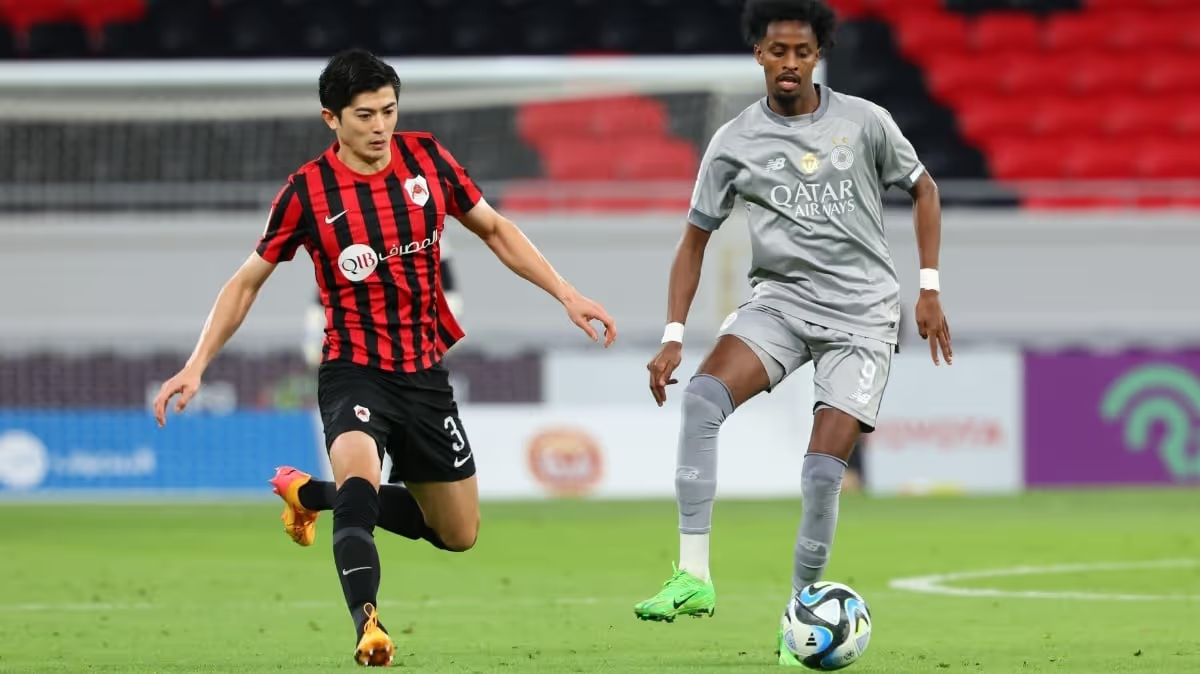
SkillCorner has partnered with Scouted Football, providing data and insights to support their writing on the best emerging talent in football. In this article, the Scouted team used Physical and Game Intelligence data to analyse the level of some of the top leagues in the AFC, relative to European leagues.
The Asian Football Confederation is a mystical footballing institute. Stretching from Uzbekistan in the north to Palestine in the west and Australia at its most southern and eastern edges, the AFC collates a truly diverse mix of footballing styles and cultures.
Its breadth is represented every year in the AFC Champions League, which in the past decade alone has been won by teams from South Korea, Saudi Arabia, China, Australia and Japan.
In few other places does football offer such a union of disparate cultures and styles. And yet the AFC Champions League — and all the domestic leagues beneath its umbrella — has never been a particular breeding ground of top talent.
The AFC will be 70 years old next year. The AFC Champions League ran for the first time in 1967. This is not a new organisation or competition. And yet, with the growing profile of its members in the Arabian Gulf and a trickle of youth talent heading to Europe from others, the AFC is wrapped in a mood of new beginnings. Some might say a revolution.
As with all revolutions, the upheaval will be great. For the AFC and its member states to grow in stature, they must learn to nurture the talent they produce and develop it to be valuable to the market that pays the most: Europe. The foundations are being laid.
So let us examine those foundations, in pursuit of understanding how the AFC’s leagues stand as a prospective market for European clubs right now, and what they still need to do to produce top, Europe-ready talent on the regular.
What’s the standard of football in top AFC leagues today, and how does it differ to Europe? How can these leagues adapt to ensure their players become and remain valuable to European scouts? And what stylistic trends are obvious when watching AFC leagues, so European scouts might search with more informed eyes?
We’ll investigate these questions using data from across SkillCorner’s range of offerings, including Off-Ball Running, Physical, Passing, and Dealing with Pressure.
And we’ll be covering five top leagues - the Saudi Pro League, J1 League, K League 1, UAE Pro League, and Qatar Stars League - in search of revolution Asia: the foundations of football’s future.
The running game
Let’s dive straight into some data to understand where these leagues stand right now.
First up, let’s look at the spread of Physical data from the SkillCorner package, which is revealing in terms of the athletic differences that separate these leagues.
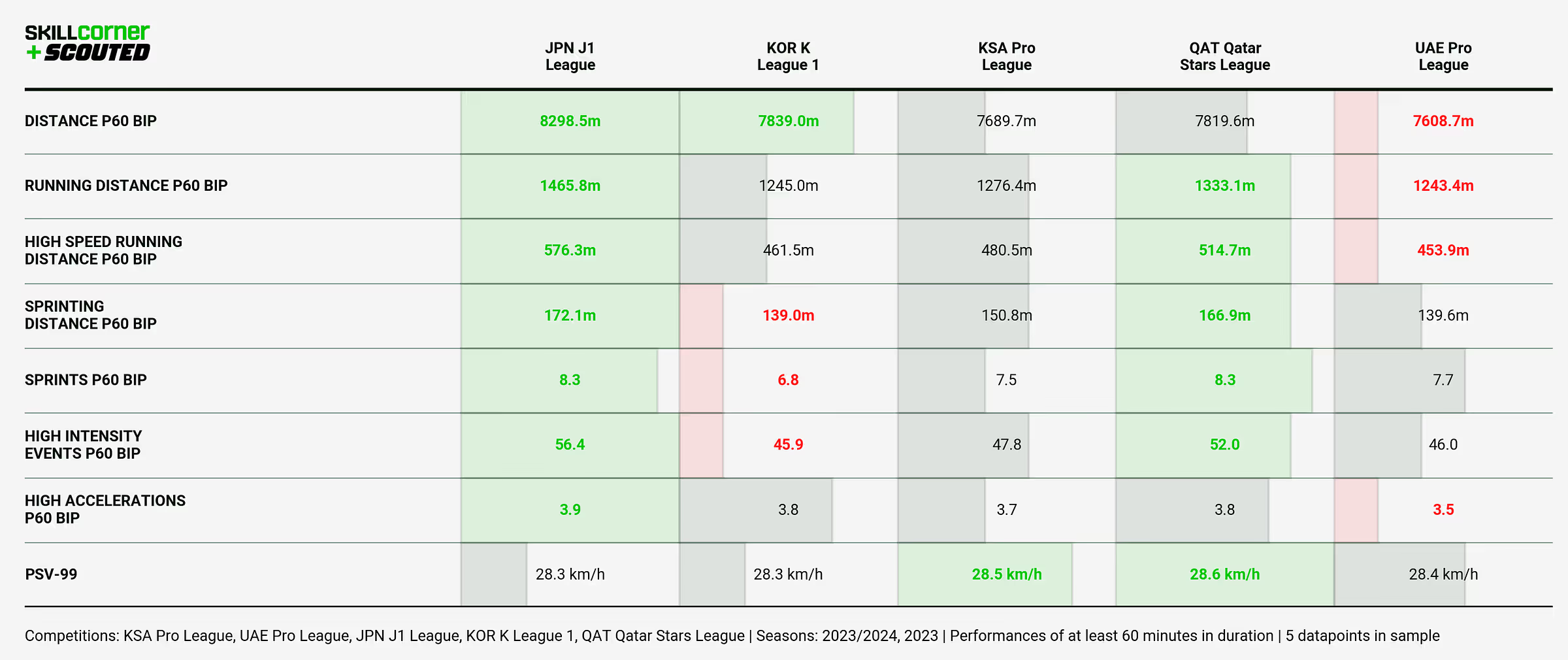
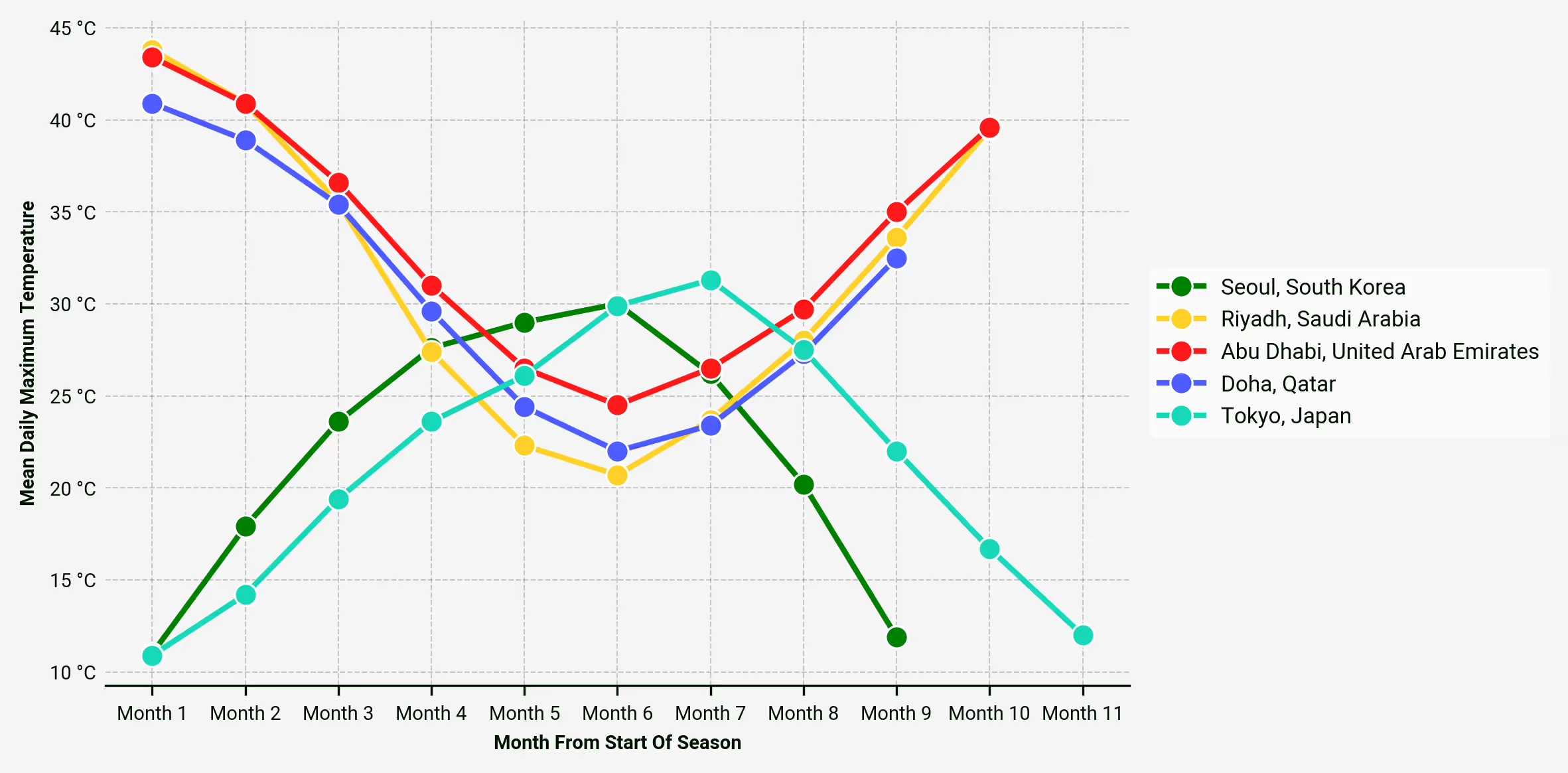
The interesting outlier is the Qatar Stars League, whose clubs play their games during these warmer periods of the season in air conditioned stadiums, before shifting to smaller, traditional home venues. Here’s a hypothesis I had never thought of before: it seems these facilities could have a significant effect on how an entire league plays football, and as a consequence, the type of player it develops. Here are some running data comparisons between the Qatar Stars League and the Saudi Pro League in the warmest months of the season in August-September (when the QSL played in air conditioned World Cup stadiums for the first five matchdays), and the coolest months of December-January.
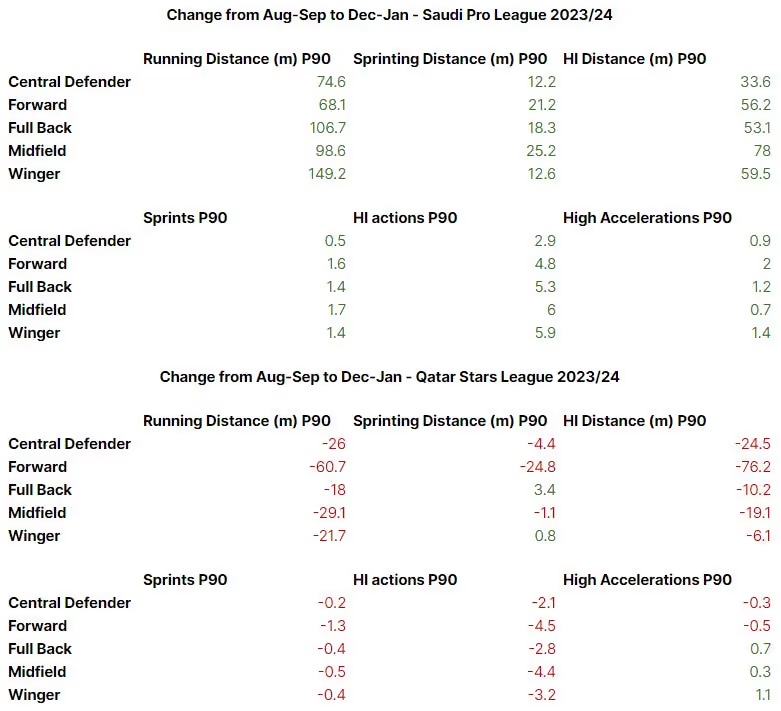
It seems plausible that there’s at least some causal link between Qatar’s climate-controlled stadiums and higher athletic output in the warmer months in the season, especially considering how much the athletic level of the Saudi Pro League increases as it enters the cooler months of the season.
A point of interest: Al-Sadd’s Jassim bin Hamad stadium has had air conditioning for around 15 years, and their squad has provided the backbone for the Qatari national team that has won back-to-back Asian Cups in 2019 and 2024, supplying 9/23 and 11/26 members of those squads. Importantly, that included key figures such as captain Hassan Al-Haydos and 2023 Asian Cup Golden Ball winner Akram Afif.
The major outlier, though, is the K League 1, which ranks quite low amongst a range of these metrics without any of the Gulf’s climate impacts.
Again, a lot of this reflects on the national team, whose Asian Cup campaign this year was a disaster. Despite possessing star talent in the form of Son Heung-min, Kim Min-jae and Lee Kang-in, Jürgen Klinsmann’s side looked lethargic, moved the ball slowly, and were carried through the tournament by the sheer quality of their best players, before ultimately succumbing to Jordan in the semi-finals. The Korean Football Association must have agreed with that summation, as they recently decided to relieve Klinsmann of his duties as head coach.
The wildcard theory is that something unquantifiable makes a league or nation play a certain way: their long-established national identity. The Spanish have the possession game, the Italians have catenaccio, and the Koreans have always been a workmanlike side that favours rigidity and solidity above all else. It can be hard to break that mould once it’s ingrained.
Another impact on intensity is the much-discussed ball-in-play time.
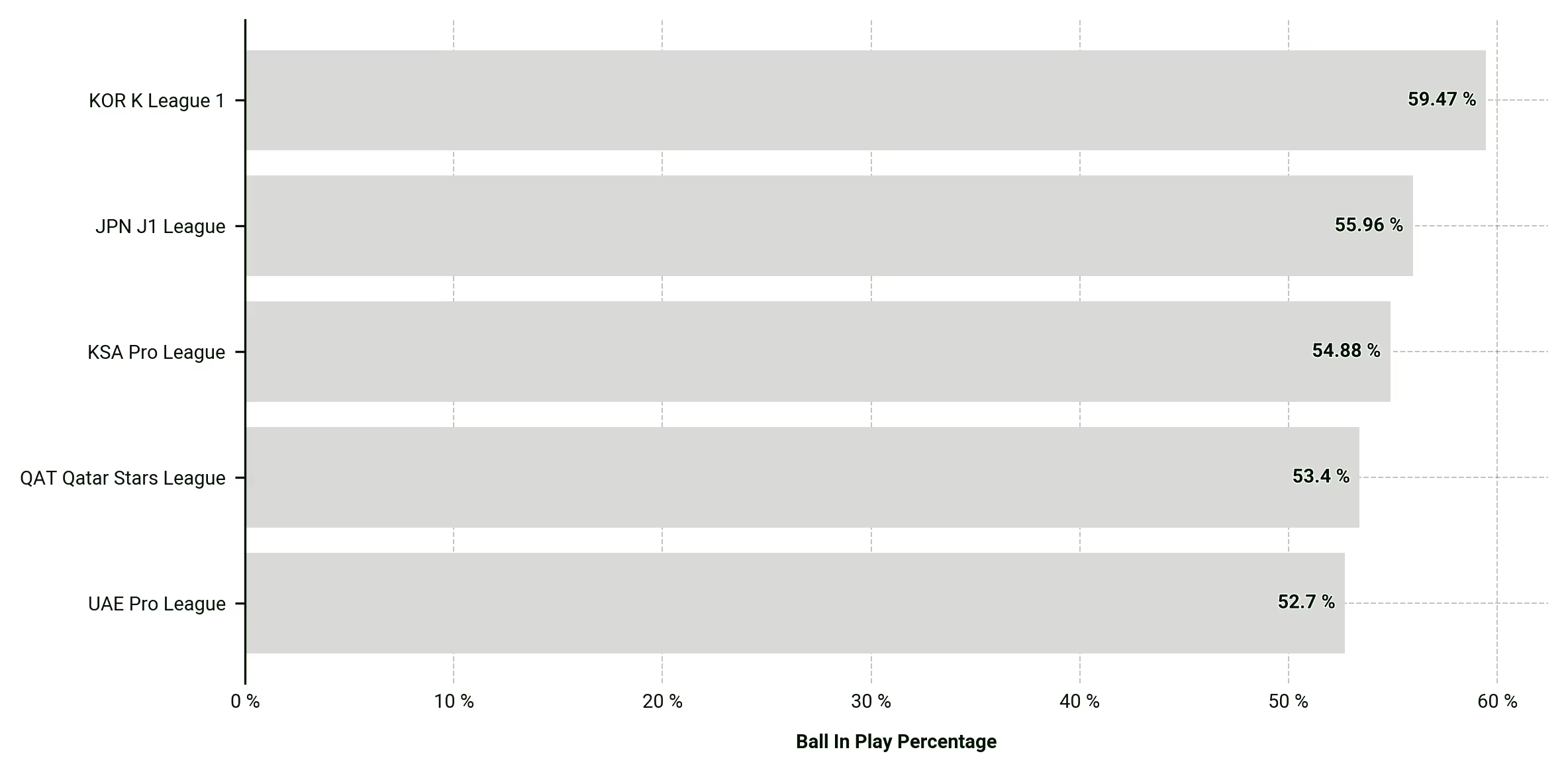
As you can see above, the K League 1’s ball in play percentage is miles ahead of the other leagues, which means there is less time for players to recover between sequences of play.
On the other end of the spectrum, the UAE Pro League has the least ball in play time, but still ranks poorly across our range of physical metrics. This is probably overridden by weather impacts, amongst other things.
Lastly, let’s compare our five leagues by the age of their players:
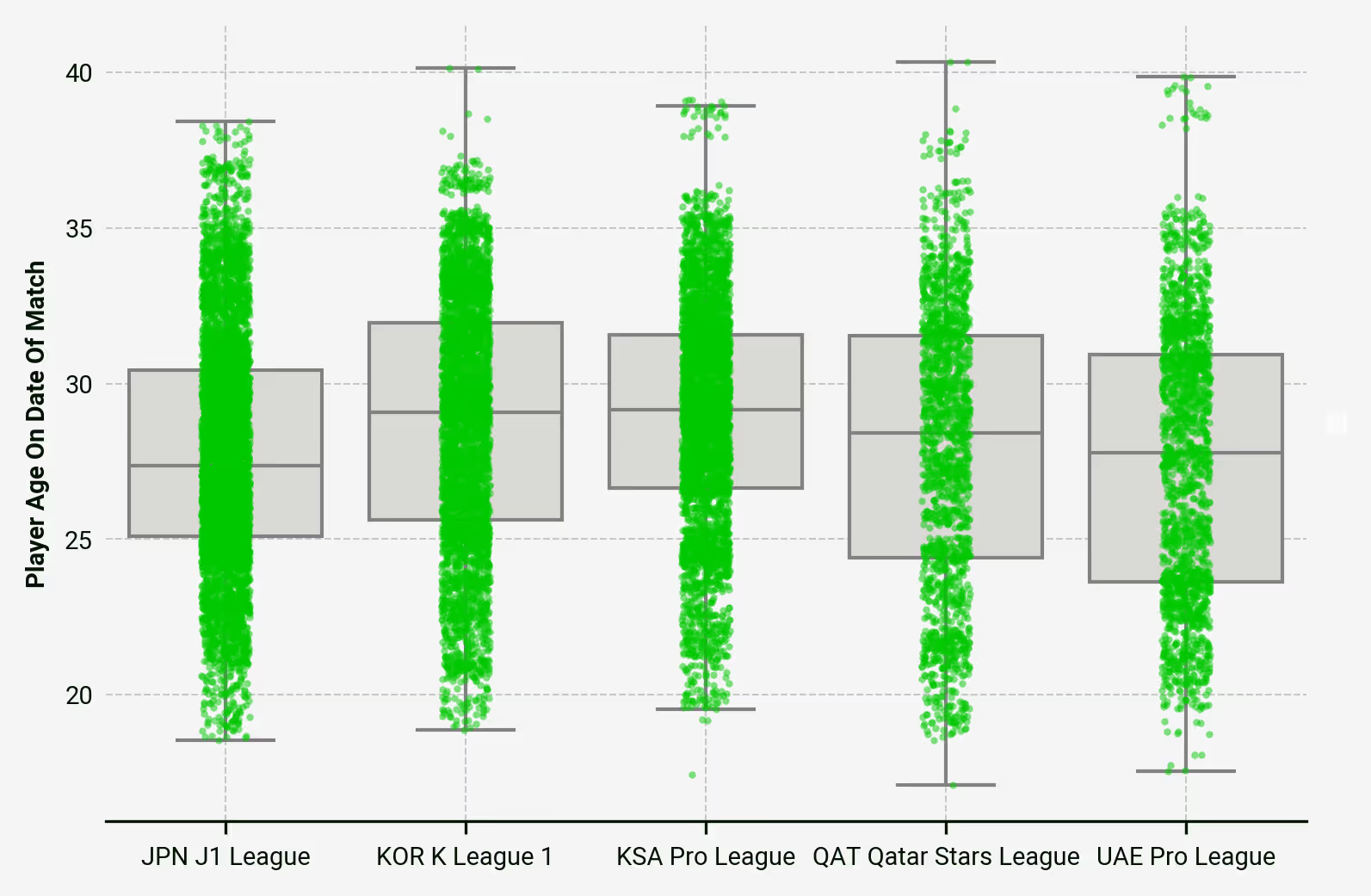
The technical standard
The pace of play in Japan and Qatar clearly has major flow-on effects in other aspects of how these leagues play. This is especially true in the J1 League, a league basically everyone rates highly for the calibre of technical players it develops.
Interestingly though, the J1 League ranks lowest amongst our five chosen AFC leagues for ball retention ratio under pressure.

I must stress that ranking low on this metric doesn't necessarily mean we’ve been duping ourselves about the quality of players coming out of Japan — the answer to that speaks for itself with players like Kaoru Mitoma, Kuryu Matsuki, etc.
It’s interesting to note that Qatar — ranked second across most of SkillCorner’s physical metrics — is the second-lowest ranked league for ball retention ratio under pressure/high pressure.
Crucially, this is where you start to see some major gaps emerging between Europe’s top-five leagues and the AFC.
While maintaining a very similar athletic standard to the J1 League, Europe’s top five leagues are able to maintain higher ball retention numbers. Basically, as the speed and intensity ramps up, across the board players in Europe’s top-five leagues are still able to be more efficient than J1 League players.
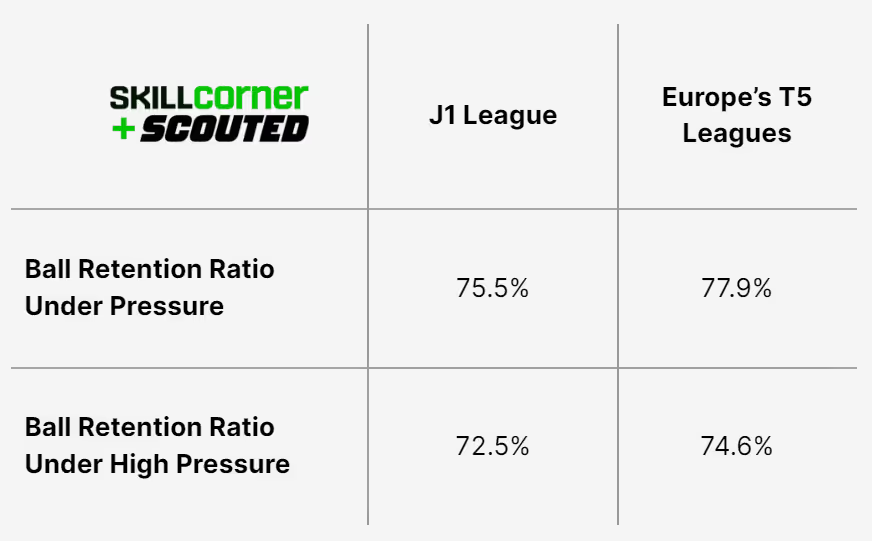
For all we talk about the technical level of the J1 League, we must acknowledge that Europe’s top-five leagues are still a step ahead. Japan is on a solid trajectory though, and it points to why the cream of the J1 League crop are consistently able to forge good careers in Europe.
On the flip-side are the Saudi Pro League and UAE Pro League numbers. I will say that I think people in Europe consistently underrate the quality of these leagues. Clubs like Ah-Hilal and Al-Ittihad in Saudi Arabia and Al-Ahli and Al-Ain in the UAE are amongst the most successful clubs in Asia, with six AFC Champions League titles and nine runners-up medals between the four of them — with the vast bulk coming in the last 25 years.
That being said, the slower pace of play is definitely a factor that enables quality players in these leagues — especially with the 2023 influx of European stars into Saudi Arabia — to take more care of the ball.
These two leagues rank highly for their safe pass ratio under pressure — meaning their players are taking less risks and paying more attention to maintaining possession.

Interestingly, the top-five leagues in Europe also rank quite highly in this stat, although still much lower than the Saudi Pro League. (This also does go some way to explaining part of the gulf between Europe and the J1 League in terms of ball retention).
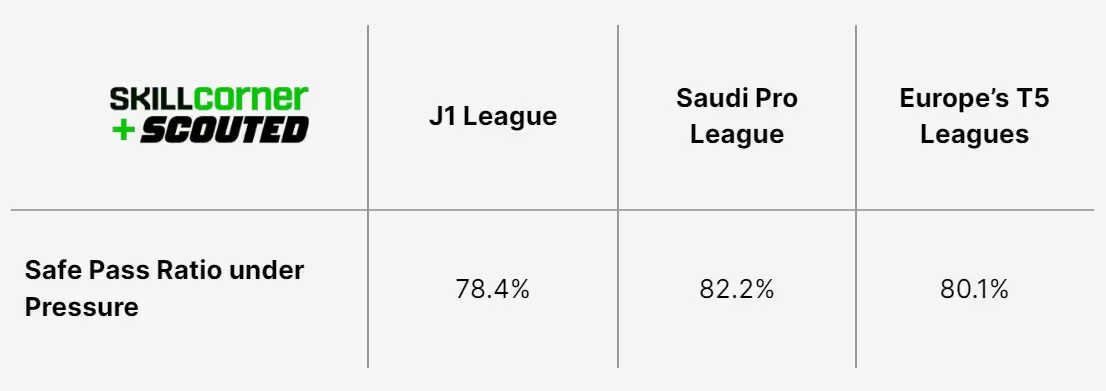
As always, K League 1 is the bizarre outlier. It ranks poorly across a bunch of key physical metrics, but still remains quite middling as a league for ball retention metrics. This remains true while the league has the lowest ratio of high pressures amongst our selected AFC Leagues.
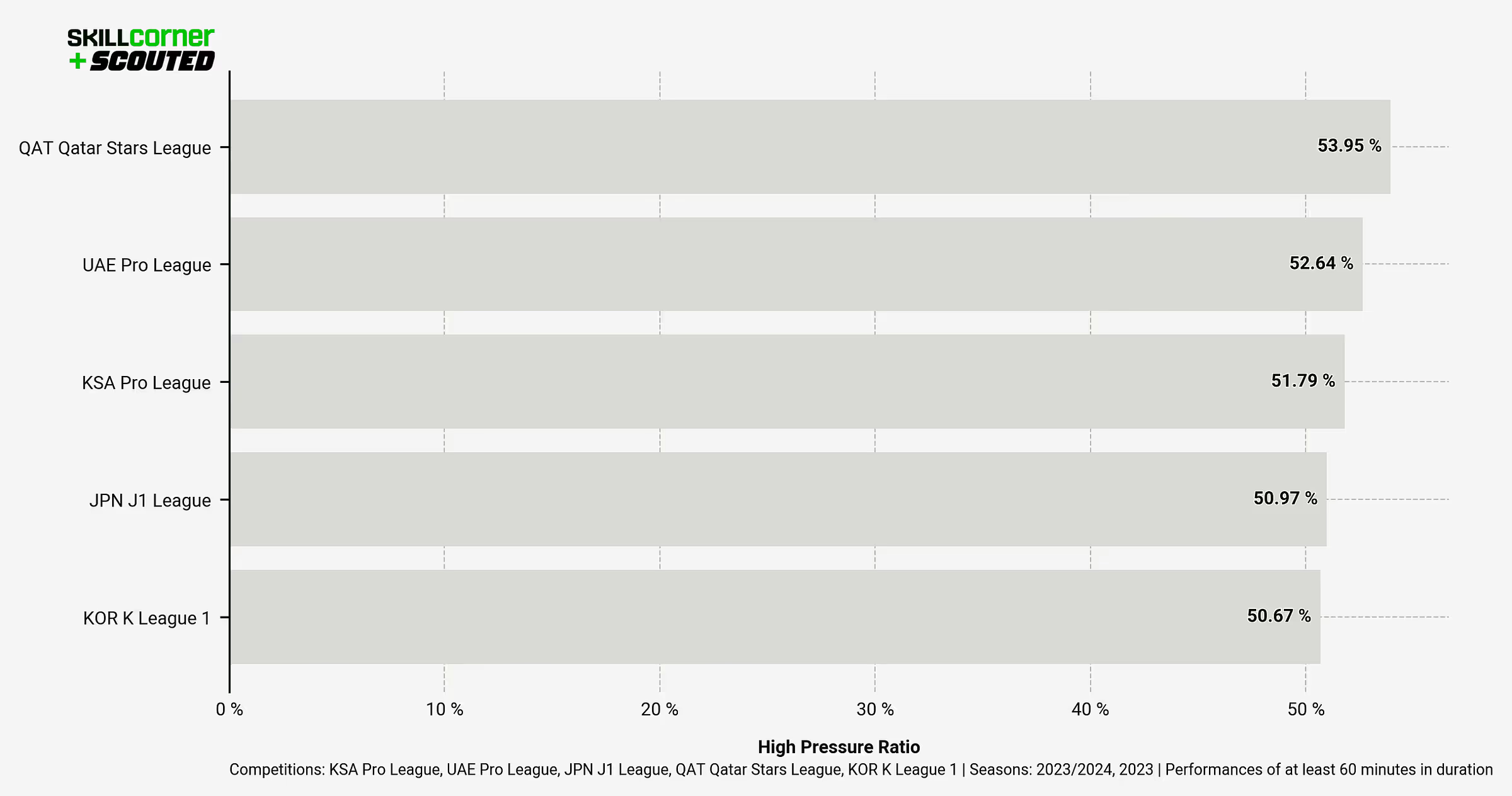
Interestingly though, Korean clubs have been extraordinarily successful in the AFC Champions League in the last 15 years. But the league has not churned out high-quality attacking players like the J1 League has: Lee Kang-in moved to Spain at age 10, Son Heung-min was in Germany with Hamburg at 16, and Hwang Hee-chan left Pohang Steelers to join Salzburg at 19, without having played a single K League 1 game.
Conversely, the K League does not have a great record with selling players that are developing later, within their league system, directly into Europe. Even Kim Min-jae had a couple of years in China before moving to Turkey and then Italy.
Attacking mentality
Perhaps one reason the K League struggles to develop players for Europe is the defensive nature of its leagues.
It consistently ranks low amongst global top divisions for goals per game, sometimes failing to break an average of 2.5 per game over the course of a season.
What are the SkillCorner metrics that can flesh out exactly how this happens? Athleticism and technical quality cannot fully answer this question, so let's look at some Off-Ball Running metrics.
What we have found is quite illuminating, with the K League 1 ranking well-behind our other AFC leagues across a range of measures, including runs, dangerous runs, percentage of runs that are dangerous, and threat per 100 runs.

By contrast, the other leagues are quite balanced. The J1 League is the most active in terms of runs, but slightly less direct as reflected in less dangerous runs, while the three Gulf leagues swing the opposite way, with less runs overall but a much higher proportion of runs that are dangerous.
In terms of answering one of our foundational questions of this piece — how can clubs in these leagues adapt their playing style to be more in line with the top leagues in Europe, and thereby make their players more valuable to the European market? — it seems that this is the area in which Korean football needs its greatest rethink.
Overall though, in terms of being most correlated to the top five European league standard, it is again the J1 League that reigns supreme.
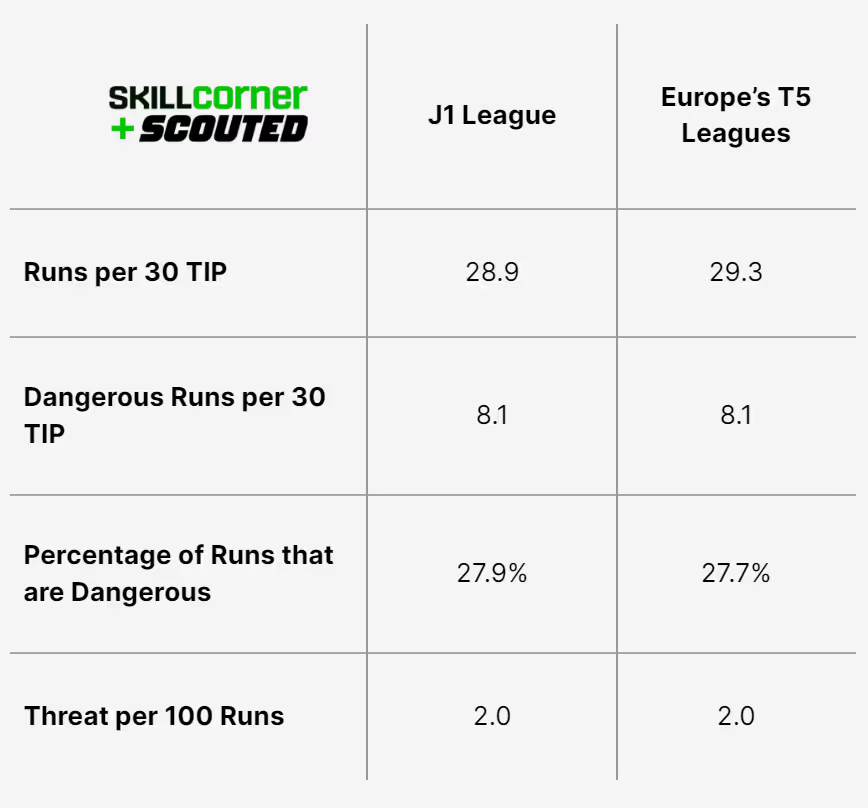
It might seem a coincidence that the J1 League mirrors the top-five European level so closely, but this would be discounting the foundational importance the Japanese Football Association places on youth development and following the stylistic trends of the sport.
This excerpt on the JFA website was very illuminating:
“Japan has been observing the world football's trends of development and has been developing, learning many things from the strong football of foreign countries and creating its own system.
There was a period in which Japan was imitating world top class countries and had to play coping opponent's characteristics, but in this way, it is impossible to become one of the world's top 10 teams and to debut in the world.
In order to make Japan reach and overtake world's top class countries, overcoming domestic wins and losses, we must continue observing and learning world football's trends of development and, instead of imitating other strong countries, we should pursue and establish Japan's own football, making the best use of the qualities of Japanese players.”
In short: it’s global football with Japanese characteristics.
There’s lessons like that for a lot of leagues and federations around the world.
Directness
Lastly, let’s touch on some passing numbers, which will give us a good idea of the directness of our AFC leagues.
Naturally, given the amount of runs made by J1 League players, players in possession have lots of opportunities to pass to runs. However, quite clearly it is the three Gulf leagues, headed by the UAE Pro League, that are most aggressive and direct at looking to pass to off-ball runners.

There are a lot of numbers here, but they are all tied quite closely together. As a whole, they tell us that when there are opportunities to pass to runners, players in the UAE Pro League will look to access those runners more often than in other leagues, while maintaining strong completion ratios across the board.
Again, I think a lot of this points to overall stylistic/defensive qualities of the leagues, with the UAE Pro League and Qatar Stars League being by far the two highest scoring leagues of our five, as we see them ranked one and two for completed passes to dangerous runs, pass completion ratio to dangerous runs, etc.
Something those two leagues will have to think about is whether such high scoring is healthy for the overall playing standards, and what fuels the weakness. Is it something to do with coaching in the league? Is it defensive player development?
One way I like to break this down how ‘good’ defending is/how ‘good’ defensive structures are — something that was particularly relevant in my World Cup comparison piece — is the ability for players to complete dangerous passes in behind.
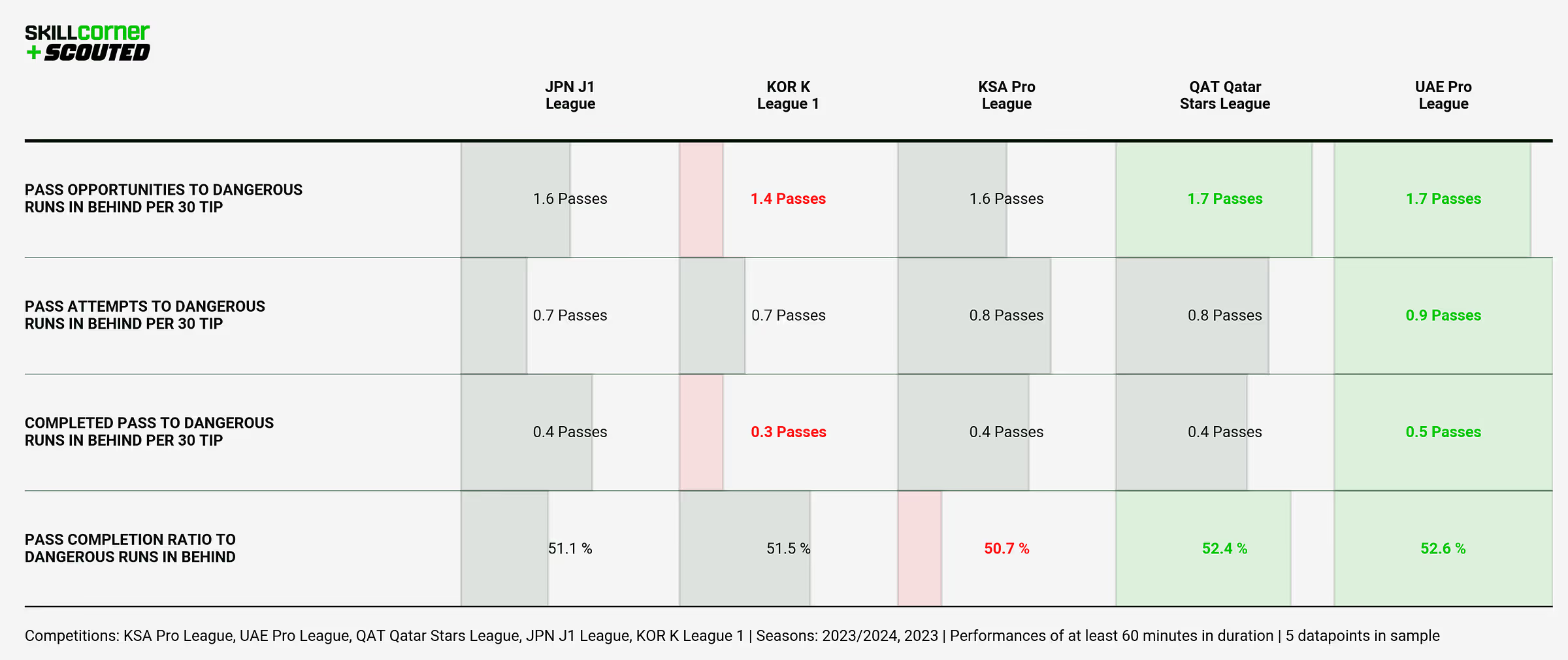
Again, we see the Qatar Stars League and UAE Pro League leading the way across basically all metrics. I would contend that the slower build-up style of the J1 League and K League 1 allows for better defensive structures that restrict the volume of good counter-attacking chances.
The runs in behind metric can also give us an interesting look at how these leagues do build-up, with the interesting quirk being which position is making dangerous passes in behind?
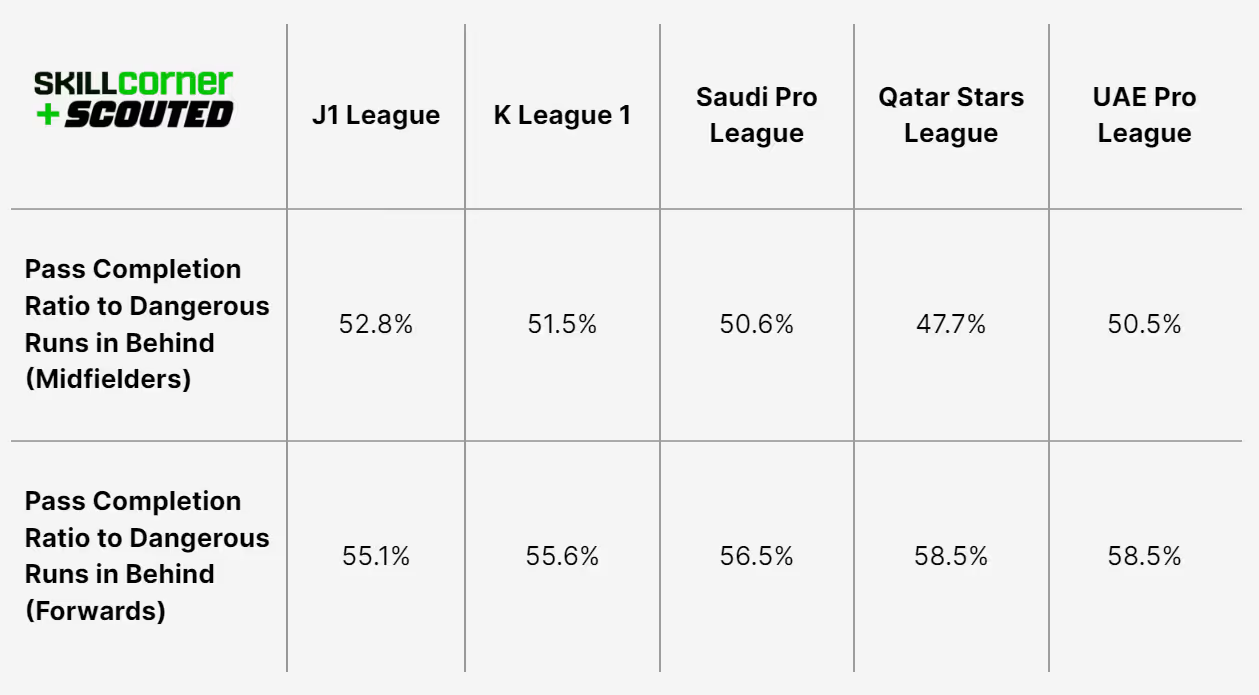
The more direct leagues in the Gulf are much more efficient when their forwards are making runs to dangerous passes in behind, while the opposite is true for midfielders. I would suggest this is more due to the structure of slow build-up play and counter-attacking in how it facilitates chance creation more than anything else.
Overall though, you will again see the passing profile of Europe’s top five leagues converge most closely with the J1 League.
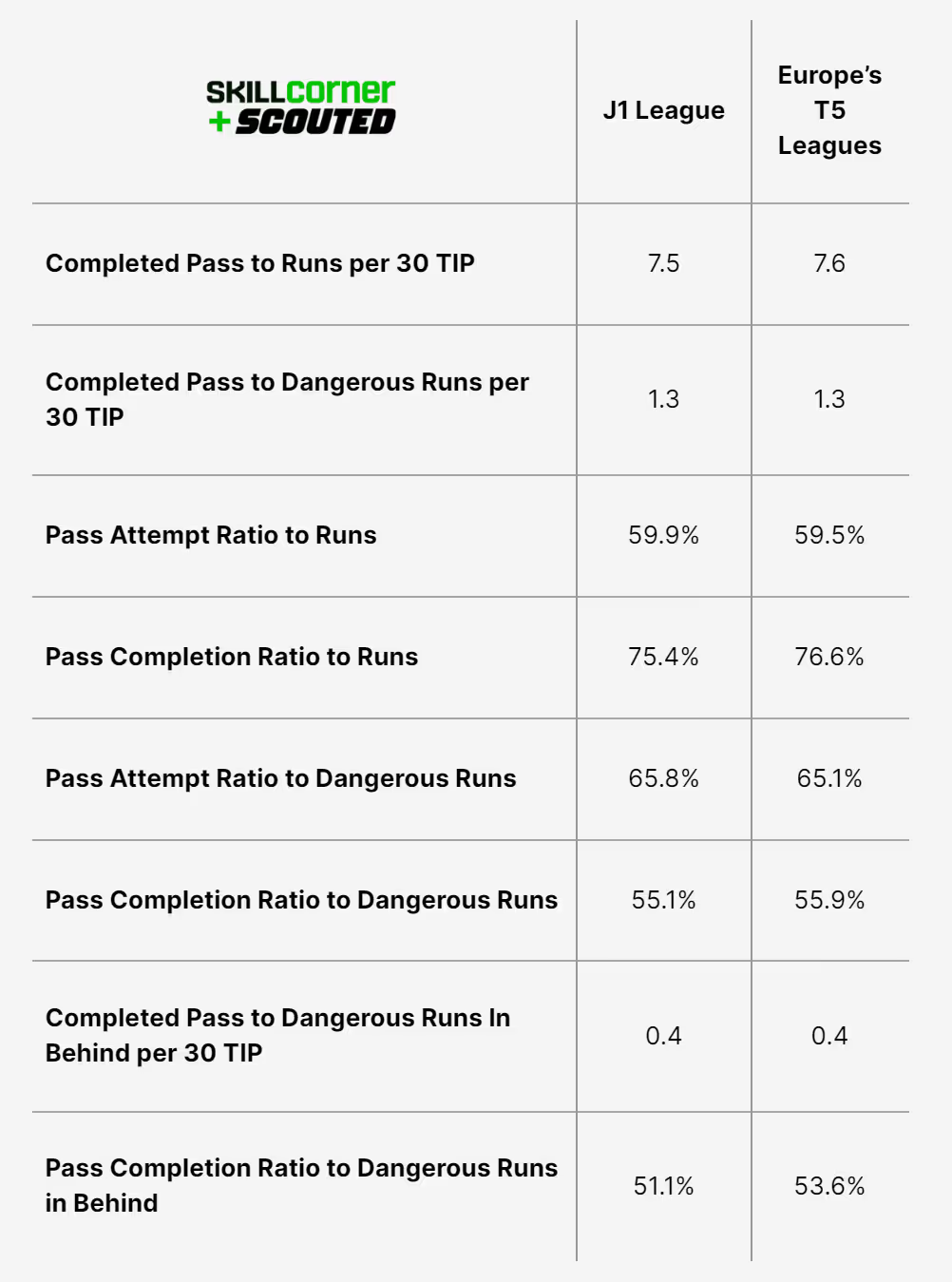
The state of the leagues
With all that being said, let’s summarise our leagues as a whole:
🇸🇦 SAUDI PRO LEAGUE
> Middling running intensity that ramps up in the cooler months of the season.
> Direct, high risk attacking with aggressive off-ball running, paired with aggressive, direct passing style.
> Solid technical level, perhaps influenced by an influx of European players.
🇯🇵 J1 LEAGUE
> Most closely correlated to the top-five European leagues.
>High running capacity overall and high intensity running, but lacks the explosive top speeds (PSV-99).
> Not direct build-up in terms of passing to runs, but intricate in terms of low safe pass ratio and high difficult pass ratio under pressure. A different version of risk taking that exposes and challenges the technical level of their players.
> Active off-ball running, but within the confines of their style — less runs ahead of the ball and in behind, but more supporting runs that suit their more possession-based style. This results in lower scoring (2.54 goals per game in 2023).
🇦🇪 UAE PRO LEAGUE
> Lower intensity running, perhaps influenced by the climate of the region.
> Uber-direct passing style to match a similar Off-Ball Running profile.
> Underrated technical base in terms of passing and ball retention, but perhaps aided by a weaker defensive level overall (3.41 goals per game average in 2023/24).
🇶🇦 QATAR STARS LEAGUE
> Great athletic level, perhaps influenced by using air conditioned stadiums in the warmer months of the season.
> Like UAE Pro League, passing and ball retention is decent, but definitely aided by poorer defensive standards (3.59 goals per game in 2023/24).
> Stylistically, the league looks like a blend between some of the passing/Off-Ball Running directness of the UAE Pro League, with the athletic standards of the J1 League.
🇰🇷 K LEAGUE 1
> Clearly the most conservative league of the five.
> Low athletic level, lowest high pressures per 30 TIP.
> Distinctly unadventurous Off-Ball Running profile; lowest dangerous runs ratio, lowest runs threat, lowest volume of runs and dangerous runs, etc.
> Only slightly less unadventurous passing profile; pass attempt ratio to runs/dangerous runs, etc.
> Similar goals per game ratio as J1 League (2.57 goals per game in 2023), but for different reasons: not because of a possession-based or control-based style, but because of a very risk-averse, defensively-oriented one.
The Revolution: Reaching the standards of a top-five European league
When we talk about the top five league standard, we do so for two reasons, with both being of differing importance to each of these respective leagues.
1. Financial boost of selling players to Europe.
This is less applicable to the Gulf leagues, but definitely a part of the puzzle for K League 1 and J1 League clubs. Selling players for big money puts more cash into the domestic football economy, which helps the league and its clubs invest more, and gives incentives to prioritise player development for more sales.
Having players that mesh with the European style will mean they are ready-made to step into that footballing culture when they move abroad, and will make the league a more attractive market for investment from Europe. (We have seen this more and more with the J1 League in recent years).
2. National team style and quality.
The top five leagues played in nations with 11 World Cups between them. Obviously, it’s a high standard of football.
Obviously, mirroring the play style exactly is not the ideal — plus, we want nations to play a unique style of football, it’s what makes the sport interesting — but the JFA mantra seems a very clever one: identify the stylistic trends, copy the bits that suit the qualities of the players you produce, and then work out the rest.
The result for Japan has been World Cup victories over Spain and Germany in 2022. Likewise, Qatar, who seem to be pushing to align their league’s style to the European model, and strongly pushing player development at the academy level through their Aspire academy project, have won back-to-back Asian Cups. Two of those Aspire academy graduates, Almoez Ali and Akram Afif, have won the last two Asian Cup Golden Balls, Golden Boots and Man of the Match awards in the final.
By contrast, South Korea and Saudi Arabia have not won an Asian Cup this century, while the United Arab Emirates have never won one.
How can leagues push towards this standard?
There is no silver bullet. Each league has its own strengths and weaknesses. But clearly there needs to be a top down approach at a league and federation level to adjust.
We’ve seen it Japan, we are starting to see it in Qatar, but it will look different everywhere. For Saudi Arabia, it might mean infrastructure investment in air conditioned stadiums that will no doubt be coming for the 2030 World Cup. For South Korea, it might be investment more into a national technical committee that sets the foundation for player and coaching development across the country, while looking at how the K League 1 can facilitate the development of its players better.
There is an incredible amount of passion for the sport in the AFC that has never quite translated to sustained success on the global stage. But the time is coming. With further professionalisation and adoption of elite level standards that we are starting to see permeate through the top leagues in Asia, the gap to the world’s best will continue to decrease.
Written by Steven Ganavas.
Click here for more information on our football products.
Click here for more of Scouted's writing on emerging football talent.

